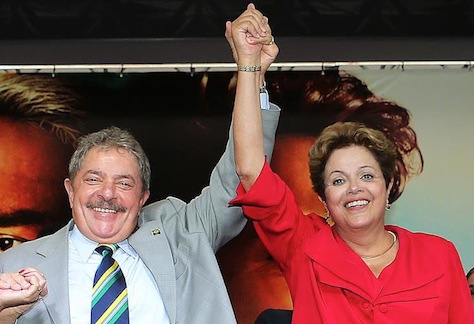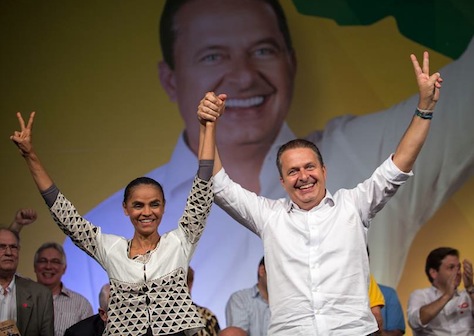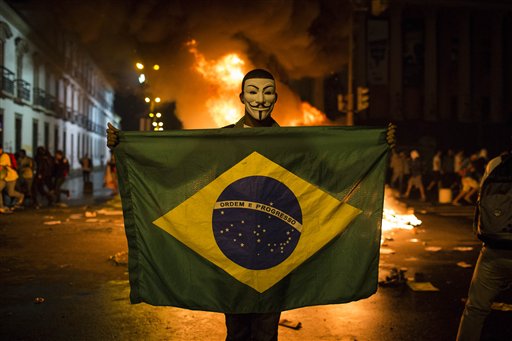It’s still Lula’s Brazil. And it’s perhaps easier to think that Brazil’s October election is less a referendum on president Dilma Rousseff’s reelection, and more the challenge of former president Luiz Inácio Lula da Silva’s Partido dos Trabalhadores (PT, Workers Party) to win a fourth term in the presidential palace at Planalto.![]()
If Rousseff, as polls currently predict, wins a second term, the Workers Party will have governed Brazil from 2003 until at least 2019 — nearly half of the period since the fall of Brazil’s last military regime in 1985.
But polls can be also misleading, and they can easily change over the course the next 65 days until Brazilians vote.
Just ask Colombian president Juan Manuel Santos, who watched a wide double-digit lead evaporate between March and May, when he narrowly lost the first round of Colombia’s presidential election to the more conservative candidate, former finance minister Óscar Iván Zuluaga. Though Santos ultimately defeated Zuluaga in the runoff two weeks later on June 14, it was an incredible scare for the incumbent — and it could have tanked the Colombian government’s historic peace accords with the Fuerzas Armadas Revolucionarias de Colombia (FARC, the Revolutionary Armed Forces of Colombia).
The stakes of Brazil’s general election on October 5 (and runoff, if necessary, on October 26, in the presidential and gubernatorial elections) are no less vital. In addition to the presidency, Brazilian voters will elect all 513 members of the Câmara dos Deputados (Chamber of Deputies), 54 of the 81 Brazilian senators, and the governors of all 26 states and the Distrito Federal.
Brazil remains the largest economy in Latin America, with promising offshore oil exploration, a rising middle class and a dynamic political marketplace. Just two decades ago, the country was rising out of military dictatorship, marked inequality, hyperinflation and economic misery. Rio de Janeiro, the country’s second-most populous city, is set to host the Summer Olympics in 2016, the first South American city to do so.
Nevertheless, Rousseff’s lead is every bit as precarious as Santos’s was in Colombia. In the October 2010 election, Rousseff was forced into a runoff by her more conservative rival José Serra, a former senator and former São Paulo mayor and governor. Though Rousseff ultimately defeated Serra in the second round by a margin of 56.05% to 43.95%, many Brazilians were surprised that Rousseff didn’t win the first-round election outright, as her predecessor, Lula (pictured above with Rousseff), did in 2006.
This time around, she’ll face Aécio Neves (pictured above), the candidate of Serra’s center-right Partido da Social Democracia Brasileira (PSDB, Brazilian Social Democracy Party).
Even in 2010, Neves would have posed a much stronger challenge to Rousseff when, as Lula’s chief of staff and former energy minister, she was running largely on Lula’s coattails.
Neves, a member of Brazil’s Senado Federal (Senate), the upper house of its Congresso Nacional (National Congress), is the former governor of Minas Gerais, and though he consistently polls far behind Rousseff in the first round, he’s trailing only very narrowly in a potential runoff.
Neves isn’t the only contender about which Rousseff should be worried these days.
Though polls show that he trails far behind in third place, former Pernambuco governor Eduardo Campos, the candidate of the leftist Partido Socialista Brasileiro (PSB, Brazilian Socialist Party), has been on the rise since the 2012 local elections and since he pulled the PSB out of Rousseff’s broad governing coalition in November 2013.
Campos could steal votes from Rousseff in the Nordeste, which has swung to the Workers Party in recent years on the strength of Lula’s social reforms. Once the plantation-heavy aristocratic heart of Brazil’s 19th century economy, the Nordeste today has become one of the country’s poorest regions and, increasingly, a reliably leftist stronghold. Campos, who briefly served as Lula’s minister for science and technology between 2004 and 2005, was elected governor of Pernambuco governor in 2007, and he won reelection with a staggering 82% of the vote in 2010.
Since 2002, when the Brazilian Socialists last fielded a presidential candidate (they supported Lula in 2006 and Rousseff in 2010), the Workers Party has floated far from its socialist roots, increasingly becoming a big-tent, centrist party just as committed to neoliberal macroeconomic policy as to promoting social welfare measures. That gives Campos an opening to appeal to disenchanted voters among the Brazilian center and left.
Campos’s running mate, Marina Silva (pictured above with Campos), was the breakaway surprise star of the 2010 general election.
Silva, who served as environmental minister in Lula’s cabinet between 2003 and 2008, won 19.33% of the vote in 2010 as the presidential candidate of the Partido Verde (PV, Green Party). She defeated both Serra and Rousseff in the Distrito Federal by a margin of just over 10%. An evangelical and one of Brazil’s most prominent figures of African descent, Silva appealed to rural Christian conservatives, left-wing environmentalists and Afro-Brazilians, but above all, she caught fire among urban, educated professionals.
While many Brazilians believe that a Silva-Campos ticket might attract more support, the Campos-Silva threat could easily gather steam in the weeks ahead. Polls widely underestimated Silva’s strength in the 2010 election, and they could equally be underestimating Campos’s strength in 2014 as well.
If no candidate wins over 50%, as expected, Brazilians will return to the polls on October 26 to choose between the top two candidates.
Rousseff’s position has only grown weaker since in her first term in office. Since her election in 2010, when Brazilian GDP growth peaked at 7.5%, growth slowed considerably — to just 0.9% in 2012 and around 2.3% in 2013. This year’s GDP forecasts keep sinking lower, with the latest at just under 0.9% among analysts. The Brazilian real, like many emerging market currencies, has lost value against the dollar since 2012, and it may still be widely overvalued. Inflation, meanwhile, is on the rise, even if it’s not as bad as in neighboring Argentina or Venezuela.
The investor class is already weighing in on the election — against Rousseff. The Spanish bank Santander published a controversial analysis last week arguing that Rousseff’s reelection would push asset values lower, and the Brazilian real has recently crept up in value as Rousseff’s reelection chances appear less certain.
Her administration has continued the popular anti-poverty programs, including the Bolsa Família program that has delivered education, health and other welfare benefits to Brazil’s poor, that made Lula the most iconic Latin American leader of his time.
But with the 2014 World Cup now over and the 2016 Summer Olympics yet to come, the Rousseff administration spent precious funds on building stadiums that many Brazilians believe would be better deployed on schools, hospitals and infrastructure. Her government has accelerated the ‘pacification’ program that’s attempted to bring both military order and police presence, along with schools and clinics, to the most notorious favelas of Rio and São Paulo, which hasn’t been without controversy.
Moreover, massive protests last summer, initially opposing a hike in public transportation costs, shocked whatever may have been left of Rousseff’s complacency when the protested widened to encompass the widespread corruption of Brazilian government and the police brutality that met some of the protesters. Rousseff responded with a flurry of legislative activity, including funds to improve public transportation, and a greater emphasis on social welfare, education and health, that attempted to meet the demands of the protests. Even in the first two years of her administration, Rousseff fired a long line of ministers tainted by corruption scandals, and the Workers Party (and Lula himself) are compromised by the mensalão vote-buying scandal and other corruption issues.
Rousseff still commands the support of a majority in both houses of the Brazilian Congress, and notably, she retains the support of the Partido do Movimento Democrático Brasileiro (PMDB, Brazilian Democratic Movement Party), formed in 1965 as the democratic opposition to Brazil’s military regime. The PMDB lingers today as a party with wide support, though it’s become such a ‘wide-tent’ party that its chief ideological principle these days is holding onto power.
Rousseff will also enjoy the support of a coalition that includes the somewhat inaccurately named right-wing Partido Progressista (PP, Progressive Party), the center-right liberal Partido da República (PR, Party of the Republic) and the center-left Partido Democrático Trabalhista (Democratic Labour Party).
But in Neves, Rousseff faces an adversary much slicker than she faced in Serra four years ago or that Santos faced in Zuluaga two months ago.
Whereas Serra seemed to personify the past and, most of all, the presidency of liberal Fernando Henrique Cardoso, Neves personifies a new generation of Brazilian leadership, and Serra routinely griped throughout 2010 that Neves and the rest of the PSDB’s young guard didn’t fully support his presidential candidacy. Serra’s hopes to lead the PSDB in the 2014 elections evaporated when he lost the 2012 São Paulo mayoral election by a double-digit margin to PT candidate Fernando Haddad, who was widely seen as Lula’s — and not Rousseff’s — candidate in the race.
Neves, however, enters the race with a few hidden strengths.
Chief among them is his record as governor of Minas Gerais between 2003 and 2010, which won international plaudits for fiscal stewardship. He cut the budget, promoted investment and otherwise presided over strong growth, boosted, in no doubt, by the same macroeconomic dynamics that so propelled the Brazilian economy during the height of the Lula administration.
With nearly 20 million residents, Minas Gerais is the second-most populous state in the country, and incorporating or essentially bordering four of Brazil’s five largest cities. Its state capital is Belo Horizonte and the state straddles the national capital of Brasília to the northwest and both Rio and São Paulo to its south, it’s the electoral equivalent of a super-state — Ohio and Pennsylvania combined. Rousseff won the state by a margin of 58.45% to Serra’s 41.55% in 2010, but certainly she won’t be able to depend on such a wide lead there this time around.
Neves’s advantage also runs to pedigree. His grandfather, Tancredo Neves (also a former Minas Gerais governor), was a chief figure in the Diretas Já campaign that demanded a return to democracy in the early 1980s and, in 1985, he was the first democratically elected president (albeit, through the Brazilian electoral college), though his untimely death in April 1985 meant that he never had the opportunity to take office.
Protest photo credit to AP /Felipe Dana.




One thought on “Rousseff holds weak lead as reelection challenge looms in Brazil”